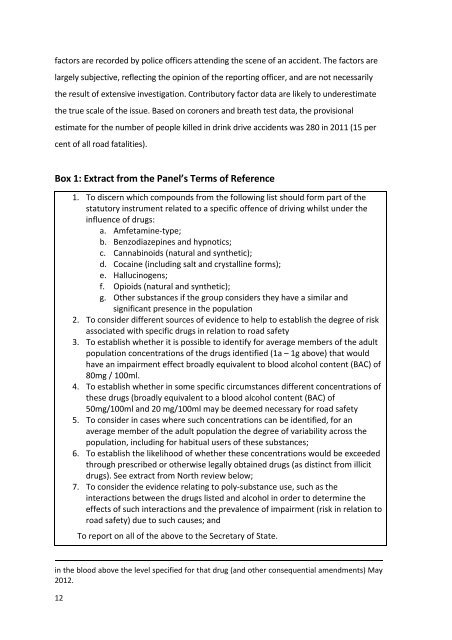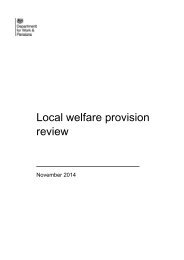drug-driving-expert-panel-report
drug-driving-expert-panel-report
drug-driving-expert-panel-report
You also want an ePaper? Increase the reach of your titles
YUMPU automatically turns print PDFs into web optimized ePapers that Google loves.
factors are recorded by police officers attending the scene of an accident. The factors are<br />
largely subjective, reflecting the opinion of the <strong>report</strong>ing officer, and are not necessarily<br />
the result of extensive investigation. Contributory factor data are likely to underestimate<br />
the true scale of the issue. Based on coroners and breath test data, the provisional<br />
estimate for the number of people killed in drink drive accidents was 280 in 2011 (15 per<br />
cent of all road fatalities).<br />
Box 1: Extract from the Panel’s Terms of Reference<br />
1. To discern which compounds from the following list should form part of the<br />
statutory instrument related to a specific offence of <strong>driving</strong> whilst under the<br />
influence of <strong>drug</strong>s:<br />
a. Amfetamine‐type;<br />
b. Benzodiazepines and hypnotics;<br />
c. Cannabinoids (natural and synthetic);<br />
d. Cocaine (including salt and crystalline forms);<br />
e. Hallucinogens;<br />
f. Opioids (natural and synthetic);<br />
g. Other substances if the group considers they have a similar and<br />
significant presence in the population<br />
2. To consider different sources of evidence to help to establish the degree of risk<br />
associated with specific <strong>drug</strong>s in relation to road safety<br />
3. To establish whether it is possible to identify for average members of the adult<br />
population concentrations of the <strong>drug</strong>s identified (1a – 1g above) that would<br />
have an impairment effect broadly equivalent to blood alcohol content (BAC) of<br />
80mg / 100ml.<br />
4. To establish whether in some specific circumstances different concentrations of<br />
these <strong>drug</strong>s (broadly equivalent to a blood alcohol content (BAC) of<br />
50mg/100ml and 20 mg/100ml may be deemed necessary for road safety<br />
5. To consider in cases where such concentrations can be identified, for an<br />
average member of the adult population the degree of variability across the<br />
population, including for habitual users of these substances;<br />
6. To establish the likelihood of whether these concentrations would be exceeded<br />
through prescribed or otherwise legally obtained <strong>drug</strong>s (as distinct from illicit<br />
<strong>drug</strong>s). See extract from North review below;<br />
7. To consider the evidence relating to poly‐substance use, such as the<br />
interactions between the <strong>drug</strong>s listed and alcohol in order to determine the<br />
effects of such interactions and the prevalence of impairment (risk in relation to<br />
road safety) due to such causes; and<br />
To <strong>report</strong> on all of the above to the Secretary of State.<br />
in the blood above the level specified for that <strong>drug</strong> (and other consequential amendments) May<br />
2012.<br />
12



